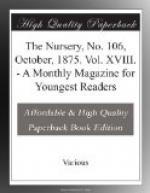OLIVE A. WADSWORTH.
ELSIE’S DUCKS.
Elsie was the daughter of poor parents, who lived on the borders of a lake. Once, when she was very ill with a fever, a good neighbor made her a present of three young ducks. Elsie was much pleased, and she soon began to get well.
Her mother would bring a large tub of water into the room where the little invalid lay; and the three ducks would swim about, and swallow the crumbs which Elsie threw to them.
As soon as she got well, she would drive the ducks down to the lake, and let them swim. They were so tame, that they would come out of the water at her call.
Sometimes her father and the rest of the family would get into a boat, and he would row across the lake to the opposite side, where some families lived who employed Elsie’s mother to wash clothes for them.
[Illustration]
At these times, the three ducks would follow the boat. Perhaps they did not like to trust their dear Elsie on the water, unless they were by to help her in case of need.
Sometimes old and young would join in a song; and then far over the lake would be heard the words:
“Come to the sunset tree,
the day is past and gone,
The woodman’s axe lies free, and the reaper’s
task is done.”
It was a very pretty sight, on a summer evening, when the bright clouds over the setting sun threw their tints on the water, to see the ducks swimming by the side of the little boat which contained Elsie and the rest of the family. It was so pretty a sight, that a good artist made a picture of the scene. We give you a copy of it here.
IDA FAY.
[Illustration]
FISHING FOR TROUT.
The trout belongs to the salmon family. Its flesh is generally of a pale pink or yellow color. It is one of the handsomest fish to be found in our waters. The variations of its tints are very beautiful; and the red spots on its skin distinguish it from common fish.
I never had much luck in catching trout. One summer I went from the city to try the trout-streams in Northern New York. I had a handsome rod, and a line nicely baited with an artificial fly; but, though I was very persevering, my success was small.
I remember sitting for hours on the slender bridge just below the Upper Cascades of Buttermilk Fall, represented in the picture; but my patience was not rewarded by the capture of a single trout. I was sorry for this; for I had depended on getting one for my dinner.
As I was about retiring, a little barefoot fellow, about twelve years old, came along with a common fishing-pole, and hook baited with a worm, and said, “Mister, I’ll catch a trout for you.”—“Do it, then,” said I.
He threw his line over a smooth spot in the pool below; and, before he had been at it five minutes, he pulled up a noble trout, large enough for a good dinner. Another and another were pulled up in quick succession. I did not know what to make of it; for I thought I had fished in a very scientific way.




